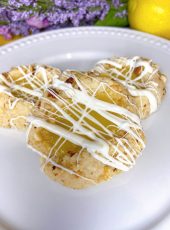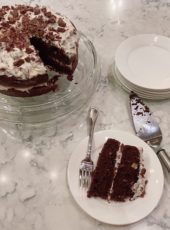Quiche isn’t as traditionally French as you think. It’s actually German! Wherever it comes from, the egg, cheese, and veggie mixture can’t be beat. And this one is super special.
“The differences between a tart, a pie, and a quiche are a blur.” – Yotam Ottolenghi
There are only a few things as French as quiche, right? If you’ve been following along with the food stories I’ve reported on, you may be righteously suspicious, suddenly cautious about answering a resounding yes. If that’s true, then you’re mastering sociology already. Food history, like all things touched by human decisions, is rarely as straight-forward as it seems. The story of quiche is a kind of French-appropriation of a food from an annexed land – how very European.
Broadly, quiche is a pastry crust or puff pastry filled with a savory custard and cheeses, meats, and vegetables. Classically, Quiche Lorraine is a savory custard pie (equal parts egg and cream) filled with bacon, and later, Swiss cheese or Gruyere. This is the quintessential “quiche-is-oh-so-French” association. This is the dish you’ll see perfected in Cafés and Brasseries, even in Paris.
The Wikipedia entry for quiche offers that the English were eating custard pastries as early as the 14th century. While there is a grain of an idea in common, custard pastries can go a lot of ways that don’t end in quiche. Besides, as Steve Heikkila jokes, if quiche were English, it wouldn’t be called quiche. It would follow “disturbing English food naming conventions” and be called something like “clotted eggy tart”; and in Middle English, “goode cloted egge teart.”

Even the website “Regions of France” admits that the popular French dish was originally German. It’s true – the word quiche comes from the German word for cake, “Kuchen.” But it gets more complicated than that. The dish was first created in the medieval German kingdom of Lotharingia in a hamlet called Lothringen. While the language spoken there was German, and the people eventually thought of as German, the region at the time was more broadly known as the Holy Roman Empire, stretching across France, Germany, Luxembourg, Belgium, and the Netherlands. French royalty thought of the Rhine River as a natural border for France. In the 17th and 18th Centuries, they made moves to annex land west of the Rhine. This included the Alsace-Lorraine region.
After the Franco-Prussian War, the Prussians annexed the region back, and for a time the Alsace-Lorraine, and quiche, were German again. During WWI, when Kaiser Wilhelm admitted defeat, there was a brief moment where the region declared its independence as the “Soviet Republic of Alsace-Lorraine.” As Heikkila jokes again, for a time quiche was the food of “the industrial proletariat.”

But in the American imaginary, quiche is far from associated with the working masses. Just the opposite – it’s right up there with lattes as a food of coastal elites. Perhaps it’s the French association; mainstream American consciousness views both European traditions and liberal politics as feminine. Perhaps it’s its presence on the lighter fare menu? If quiche is a light lunch, meat eating represents Middle America, what we’ve been told for decades is the “real” America.
In a Psychology of Men & Masculinities article, titled “Real men don’t eat (vegetable) quiche: Masculinity and the justification of meat consumption,” Rothgerber argues that men eat meat to feel like real men. While women tend to passively de-emphasize meat eating with cruelty to animals, young undergraduate men in his study tended to hyper-emphasize the pride they took in eating animals. Eating meat showed their dominance over animals and made them feel, well, like men. This was one of the first pieces of data to back up Carol Adam’s (1990) theory that eating meat represented a kind of sexual politics, and that vegetarianism was a natural choice within feminism. Notice that the title uses quiche as the antithesis of eating meat.
My parents and I have been making this delicious quiche recipe for years. We make it for special occasions and fun weekend breakfasts. It’s called summer quiche because it’s best when tomatoes are in season, but we’ve been known to eat it around Christmas too. I like to give credit for recipes when I can, but I can’t find the source on this one. We use a recipe cut out of magazine, but the title of the magazine is missing. And I haven’t found it through any internet searches. The star of the show is the fresh basil and bright vegetables – choose any favorite cheese and you’ll be happy.
Summer Quiche
Recipe by MauraCourse: BrunchDifficulty: Easy8-12
servings30
minutes40
minutesIngredients
2 TBSP EVOO
1 small red pepper, chopped small
1/2 purple onion, chopped small
2 cloves garlic, minced
2 TBSP fresh chiffonade basil
4 eggs
1 cup half & half
1 TBSP salt
1/2 tsp pepper
2 cups Monterey Jack cheese, shredded (see Note 1)
1/3 cup Parmesan cheese
3 plum tomatoes, sliced (see Note 2)
Directions
- Pre-bake pie shell at 425 degrees for 10 minutes and set aside. [see Note 3 if you have never pre-baked before.]
- Decrease oven temperature to 375 degrees
- Sauté bell pepper, onion, and garlic in EVOO for about 5 minutes, until tender
- Take off heat and stir in basil
- Whisk eggs and next 3 ingredients
- Stir in vegetables and cheese.
- Pour mixture into pie shell and top with sliced tomatoes
- Bake for 40-45 minutes at 375 degrees
- Let stand for at least 5 minutes before serving
Notes
- Note 1: The original recipe called for Monteray Jack, but I have used all kinds of cheese in this - Gruyere, Swiss, Manchego - BellaVitano Merlot was incredible! Through in whatever you want and add a little more cheese than it calls for to make it even better.
- Note 2: I like to seed the tomatoes to keep the quiche from getting too watery. Before you start, slice tomatoes and lay them out on paper towels. Sprinkle with a little salt and flip after a few minutes. It only takes about 10 minutes to remove a lot of excess water and seeds.
- Note 3: To blind bake, prick the bottom of the shell with a fork all over. Lay down some foil or parchment paper and fill with baking beads or a substitute like dried beans. If you don't do this your pie shells will slump from the sides into the base and it might be a real mess!





